TetraPOT Green Sea Defence by Sheng-Hung Lee & Wan Kee Lee |
Home > Winners > #47931 |
 |
|
||||
| DESIGN DETAILS | |||||
| DESIGN NAME: TetraPOT PRIMARY FUNCTION: Green Sea Defence INSPIRATION: The current artificial sea defence structures tend to be dislodged over time by the force of the ocean constantly crashing against them. They have also been criticized for destroying the natural scenery along coastlines. As for natural sea defence, more than 35% of the world’s mangroves are already gone because of the greenhouse effect. We identified not only some challenges that we need to face but also found some opportunities that we’re going to focus e.g. Under mutual benefit/value theme, we will create symbiosis between artificial sea defence and natural sea defence. ARTIFICIAL SEA DEFENCE - Tetrapod means "four legged" in Greek. These four-legged tetrapods are nothing but structures made of concrete and used to prevent coastal erosion. Its structure is used as an armour unit on breakwaters. The tetrapod's shape is designed to dissipate the force of incoming waves by allowing water to flow around rather than against it, and to reduce displacement by allowing a random distribution of tetrapods to mutually interlock. ENVIRONMENT ISSUE - Scientific research states that tetrapods in fact accelerate beach erosion by disturbing the natural processes that shape the coastal environment. It is also been said that the wave action on tetrapods pulls the sand away from the shore faster than what happens in the natural process. PERCEPTION - Tetrapods have been criticized for spoiling the natural coastal scenery. It is awkward and does not fit in the context. HUMAN - Though tetrapods are helpful structures, they also face a lot of criticism mainly because of their shape. People argue that they pose a danger to swimmers, surfers, and boaters. NATURAL SEA DEFENCE - Mangroves are various large and extensive types of trees up to medium height and shrubs that grow in saline coastal sediment habitats in the tropics and subtropics. Mangroves are salt tolerant trees adapted to live in harsh coastal conditions. They contain a complex salt filtration system and complex root system to cope with salt water immersion and wave action. They are adapted to the low oxygen conditions of waterlogged mud. Most mangroves are found in tropical and subtropical tidal areas including estuaries and marine shorelines. MANGROVE - Mangrove forests require stable sea levels for long-term survival, otherwise the seeds are not able to root. They are therefore extremely sensitive to current rising sea levels caused by global warming and climate change. So far, more than 35% of the world’s mangroves are already gone because of the greenhouse effect. UNIQUE PROPERTIES / PROJECT DESCRIPTION: TetraPOT is a sea defence system made of concrete. It comes with plant seeds in a decomposable pot. Randomly distributed TetraPOTs along coastlines will eventually interlock to create a long-lasting sea defence of growing trees and roots that help keep the blocks in place. As plants keep growing inside out from TetraPOT, the roots intertwine and gradually form a natural sea defence. The design not only prevents soil erosion, but also helps to protect and create a natural habitat. OPERATION / FLOW / INTERACTION: 1. Arrange TetraPOTs with mangrove seeds held by organic layers along the coastline in an interlocking way. 2. When the sea level goes up, water will be collected in the recess part inside TetraPOT. 3. As tree grows, the organic layers start to be decomposed with roots reaching down to the bottom for water. 4. Tree roots start to come out from designated channels over a certain period of time. The roots will then grab the land, forming a natural sea defence and a sustainable coastal environment. PROJECT DURATION AND LOCATION: TetraPOT definitely is an environmental friendly sea defence design and brings sustainability, eco, safety and healthy to habitat and creates a suitable place for all kinds creature around. The project started in August 2014 in Taiwan and finished in February 2016 in Shanghai, and was exhibited and presented at IDEO Shanghai in January 2016. FUTURE PLAN - 1. Cooperate with the government to have an access to place for experiment. 2. Support by academic field to have detailed scientific research and analysis. 3. Share at online platform to gain more attention and resources from the world. FITS BEST INTO CATEGORY: Social Design |
PRODUCTION / REALIZATION TECHNOLOGY: We take the manufacturing process into consideration. Less material, less steps, time and no need to artificially maintain sea defence, because plants will eventually grab TetraPOTs and hence sustain stronger sea defences. 1. Assemble and bolt 3 pieces of metal cases at the coastal line. 2. Place core pillar on the top of edge of metal case. 3. Insert 3 sub-pillars separately to hole of metal case outside and attach to the core pillar inside. 4. Pour concrete from the gap of the cover on the top. SPECIFICATIONS / TECHNICAL PROPERTIES: 1. Dimensions: 1.5m*1.5m*1.5m (L*W*H) 2. Weight: 1 ton 3. Material: Concrete, Decomposable Material, Soils, and Copper 4. In terms of product distribution, TetraPOT is currently available on the seashore, because sea defences are normally manufactured at the coastal line where they need to be placed. 5. The first date placed into distribution (products) or completed date is between 2016 and Feb 6, 2017 TAGS: Sea Defence, Symbiosis, Ecosystem, Mutual Benefit, Mangrove, Tetrapod, Environment, Sustainable, Social Design, Green RESEARCH ABSTRACT: SOCIETY & CULTURE - Via TetraPOT project, we hope it can raise people’s awareness of environmental protection issue. In the future, we want to develop the sustainable business model, eco manufacture road map, design considerations and strategy so that the project can maximize its social impact on different levels and gradually become a culture thing through out the world. ENVIRONMENT - TetraPOT not only maintains its functionality but also enhance aesthetic in terms of protecting Mother Nature. The ultimate goal is to reach a balance point between nature and artificial stuff. The project slogan is the best reflection for our goal to create a sustainability environment ”It is not only a defence, but also an ecosystem. A home for other livings.” ECONOMY - Economy always ties to environment. Human will pursuit “Green Economy” in the end, because this is the only way to make people alive and stay healthy. The project cost including designing and manufacturing time, product materials and labor for producing each sea defence are decreasing compared with the traditional sea defence design. However the design is good for the environment before hand therefore is good for economy as well. CHALLENGE: What makes the TetraPOT innovative is we create symbiosis between artificial sea defence and natural sea defence. We put more emphasis on mutual benefit, so combine “Tetrapod” with “Mangrove” which means combining “Artificial Sea Defence” with “Natural Sea Defence” In short, the perception shift will be from building more “Concrete Armor Unit” to having a “Sustainable and Greener Coastal Line”. As a result, project name is turned from “TetraPOD” to “TetraPOT” (Pot means a container) ADDED DATE: 2016-03-11 16:49:07 TEAM MEMBERS (2) : Sheng-Hung Lee and Wan Kee Lee IMAGE CREDITS: Image #1: Creator Sheng-Hung Lee, TetraPOT - Green Sea Defence, 2016. Image #2: Photographer Sheng-Hung Lee, TetraPOT - Design Highlight, 2016. Image #3: Creator Sheng-Hung Lee, TetraPOT - Design Features, 2016. Image #4: Creator Sheng-Hung Lee, TetraPOT - Manufacturing Considerations, 2016. Image #5: Photographer Sheng-Hung Lee, TetraPOT - Exterior View, 2016. VIDEO CREDITS: Mangrove between Water and Land, Lena Stenseng, 2014. Japan Tetrapods, Stick and Steam, 23 Feb 2012. Forest China-Mangroves in The Sea 1-4, Chinese Civilization Channel 2 HD, 16 Apr 2011. Into The Mangrove Forest, UnderH2O PBS Digital Studios, 2 Jul 2013. Tetrapod (structure), Wikipedia, 20 Nov 2015. Music, Lights & Motion, Aerials. PATENTS/COPYRIGHTS: Copyrights belong to Sheng-Hung Lee and Wan Kee Lee, 2016 |
||||
| Visit the following page to learn more: http://shenghunglee.wix.com/design#!tetr |
|||||
| AWARD DETAILS | |
 |
Tetrapot Green Sea Defence by Sheng-Hung Lee & Wan Kee Lee is Winner in Sustainable Products, Projects and Green Design Category, 2015 - 2016.· Press Members: Login or Register to request an exclusive interview with Sheng-Hung Lee & Wan Kee Lee. · Click here to register inorder to view the profile and other works by Sheng-Hung Lee & Wan Kee Lee. |
| SOCIAL |
| + Add to Likes / Favorites | Send to My Email | Comment | Testimonials | View Press-Release | Press Kit |







